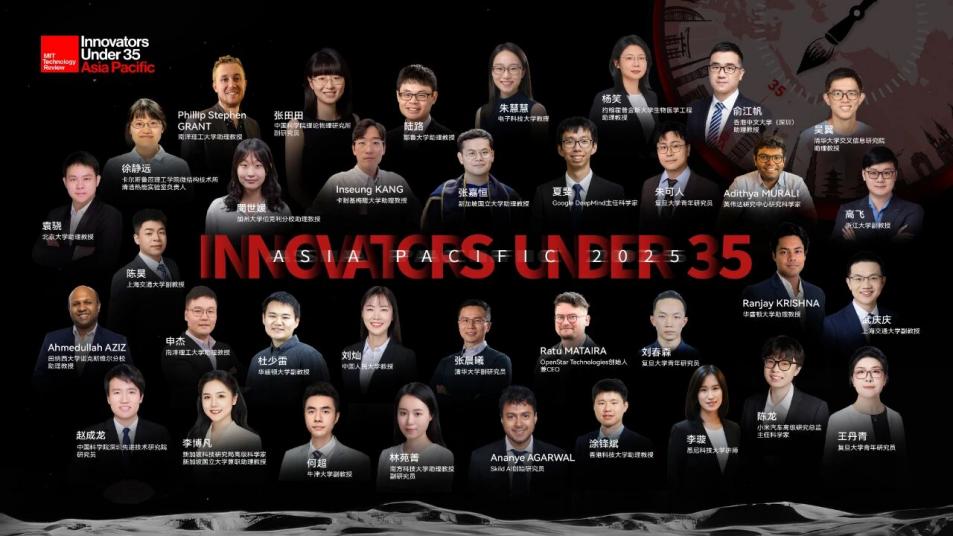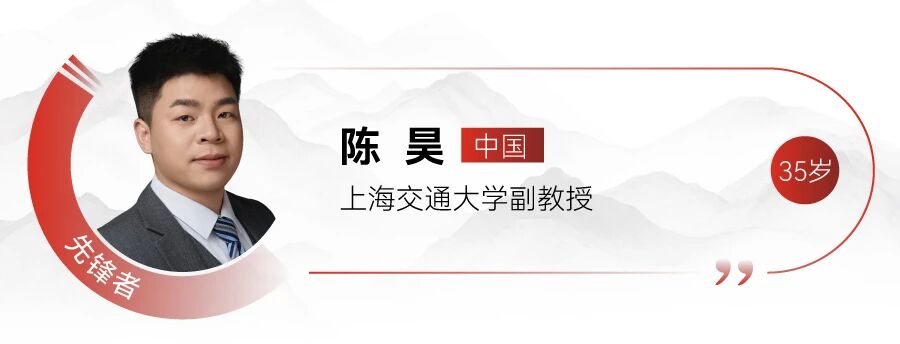GIFT Associate Professor Hao Chen Named to MIT Technology Review's 35 Innovators Under 35 Asia Pacific List
The Asia Pacific regional honoree list of the MIT Technology Review's "Innovators Under 35" (TR35) was announced in Shanghai on September 22, 2025. The TR35 list aims to recognize outstanding young innovators under the age of 35 worldwide who demonstrate exceptional potential in advancing technology and tackling some of the world’s most pressing challenges, thereby transforming the world. Over the past two decades, the TR35 has become one of the world's most influential awards for young innovators in science and technology. Since the inception of the Asia Pacific regional list in 2021, it has brought a cohort of extraordinary young Chinese innovators home and abroad to the global stage, fostering cross-regional collaboration to address societal challenges and shape a shared future for humanity. This year's cohort embodies the distinct characteristics of "Coexistence, Co-creation, and Symbiosis," offering insights into future technological trends in the Asia Pacific region and beyond. Associate Professor Hao Chen from Global Institute of Future Technology, SJTU was named to the 2025 list for his groundbreaking contributions to the field of perovskite photovoltaics.

The 2025 Asia Pacific Honorees for Innovators Under 35
(Source: MIT Technology Review China)

Citation: Hao Chen addressed some of the key challenges in perovskite devices by developing innovative interfacial and compositional engineering strategies.
Scientific Achievements and Technological Breakthroughs
Associate Professor Hao Chen's research focuses on developing highly efficient and stable perovskite solar cells, particularly in single-junction and all-perovskite tandem solar cells, achieving a series of internationally recognized results. Through innovative strategies such as interface engineering and composition engineering, he has significantly enhanced device efficiency and stability, laying a crucial foundation for the industrialization of perovskite photovoltaic technology. His work has been published in top-tier journals such as Nature and Science and included in international authoritative efficiency charts.
Chen is dedicated to solving critical challenges like interfacial losses and instability in perovskite photovoltaic devices for practical applications. In 2022, he published a paper in Nature Photonics demonstrating a novel quasi-2D perovskite fabrication process that increased the certified efficiency of inverted (PIN) structure perovskite devices from 22.3% to 23.9%. In the same year, his work published in Nature reported reducing the open-circuit voltage deficit of wide-bandgap perovskite cells to below 0.5V for the first time and achieving a certified efficiency of 26.3% for an all-perovskite tandem cell (certified by NREL), surpassing the then-record for single-junction perovskite efficiency.
In 2023, in collaboration with other researchers, he proposed a synergistic strategy combining field-effect and chemical passivation, elevating the efficiency of PIN structure devices beyond 25%. Additionally, his team developed the world's first NREL-certified all-perovskite triple-junction tandem solar cell, with related results published again in Science and Nature.
In 2024, Chen introduced a bi-functional molecular passivation mechanism that forces ligands to lie flat on the surface, enhancing carrier extraction efficiency while effectively passivating defects. This breakthrough led to a certified efficiency of 26.15% for a PIN structure device, setting a new record for single-junction perovskite efficiency at the time and surpassing the efficiency of traditional NIP structure devices for the first time. This achievement was included into the National Renewable Energy Laboratory's (NREL) "Best Research-Cell Efficiencies" chart and Professor Martin Green's "Solar Cell Efficiency Tables," marking a significant milestone in the field.

Reflecting on his journey, Chen's motivation for pursuing scientific research stems from a deep interest in clean energy technologies and a sense of mission to improve the living environment of mankind with advanced technology. He believes that technological innovation, represented by sustainable energy technologies, will shape the future and call for global collaboration that transcends national and disciplinary boundaries. During his postdoctoral study at Northwestern University (USA) and the University of Toronto (Canada), he gained a profound appreciation for the perseverance required for meaningful research and the critical importance of interdisciplinary collaboration and international exchange in driving innovation. Since joining GIFT in 2024, Chen has found the institute's philosophy of "interdisciplinary integration, boundary-breaking, and future-orientedness" highly aligned with his research direction—perovskite photovoltaics inherently involves multiple disciplines like materials science, photonics, chemistry, and engineering. The cross-disciplinary platforms and abundant support offered by GIFT facilitates frontier and integrated research, and greatly fosters an open, collaborative mindset among researchers.
Looking ahead, Chen acknowledges that perovskite photovoltaic technology still faces challenges in operational stability, scalability and cost reduction, but it is also entering a critical period of opportunity in its transition from lab to industry. He looks forward to strengthening collaboration with peers home and abroad to advance innovation in materials, devices, and systems, driving progresses toward carbon peak and neutrality goals. He also encourages young students to remain curious and explore courageously, identify new questions at interdisciplinary frontiers, and pioneer new pathways to contribute to a better future.




